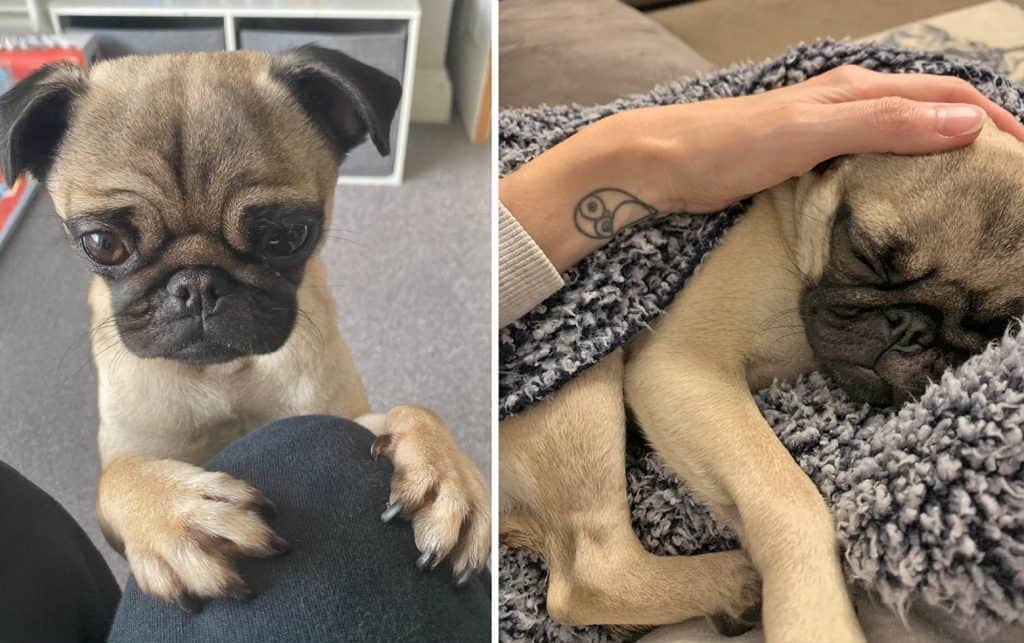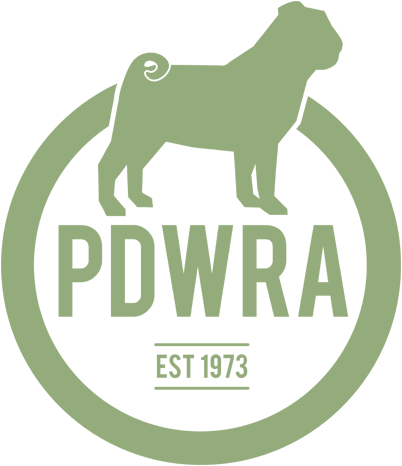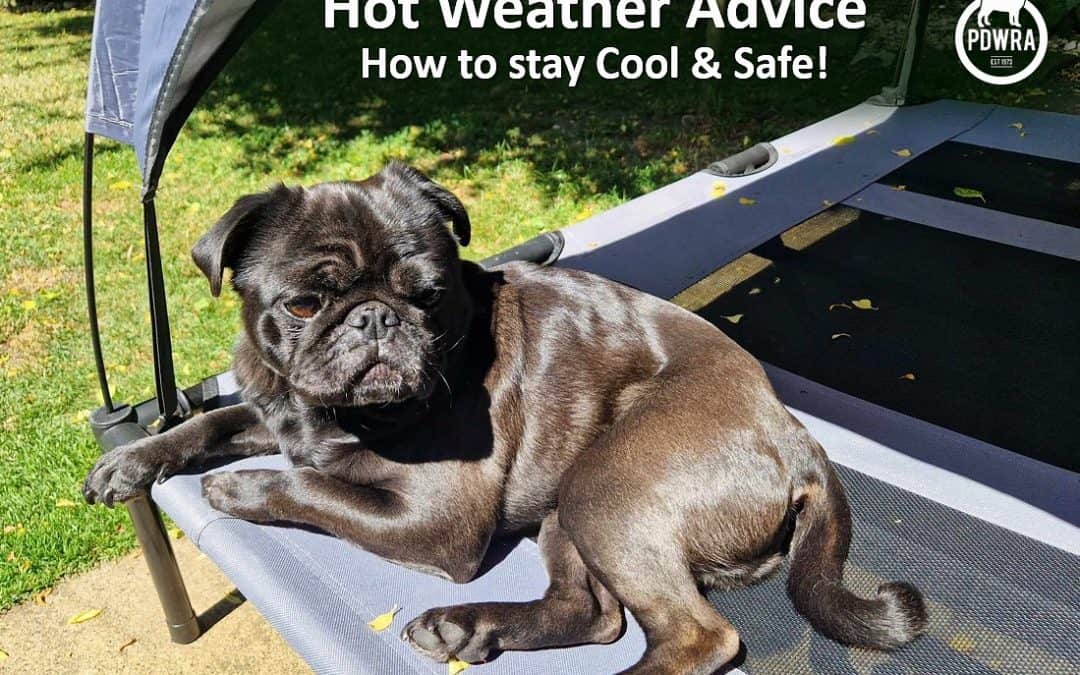
by Yasmin | 20 Jun, 2025 | Blog, News, Pug Health
As temperatures have been rising to above 30°C in parts of England for the first time in 2025, we are expecting further very warm or even hot conditions into the weekend with maximums over 30°C, before cooler and fresher air returns from the West.
This transition may also bring some thunderstorms in places.
So, here is our regular advice & tips for keeping your pugs, so sensitive to heat, cool, comfortable, and safe.
- Make sure your pug has constant access to fresh water – day and night.
- fresh fruit, chilled or frozen, make ideal refreshing & healthy treats to help keep them hydrated.
- Make sure your pug has constant access to shade and cool surfaces.
- Remember to move sources of shade as the sun moves around gardens.
- Provide cooling jackets and shallow paddling pools to enable your pug to cool down, and remember that carpets do not help pugs cool down, so provide cooling mats to help your pug cool down indoors and swap them for a spare cool mat regularly to ensure they are cool.
- DO NOT rely on fans alone to cool your pugs down as they are not as effective on pets as they are on us.
- Plan your walks
- Walk your pug in the early morning or late in the evening if the temperatures are cool enough and try to stick to shaded areas.
- If the mornings/evenings are still warm – DO NOT walk your pug!
- Particularly if they are overweight, have health issues, are elderly or very young.
- The Seven Second Test
- Tarmac /pavements even artificial grass can get very hot in the sun – hold your hand on it for 7 seconds. If it’s too hot for your hand it’s too hot for their paws. DO NOT walk your pug as they could burn their paw pads.

Temperature guide for deciding whether it’s safe to walk your pug/s.
- Below 12°C: Perfect walking weather! Your dog will be comfortable and ready to explore.
- 12-19°C: Safe for most dogs, but keep an eye out for signs of overheating if they’re running around a lot.
- 20-23°C: Start to take precautions. Stick to shaded areas, keep walks short, and bring water.
- 24-26°C: This is risky territory. Only take your dog out if it’s absolutely necessary, make it a quick, shady stroll, early in the morning or later in the evening.
- Above 27°C: It’s too dangerous to walk your dog. Stay indoors or let them relax in a cool, shaded area instead.
All dogs are individual & different, so always monitor how each of yours reacts to the heat and adjust their activity accordingly.
Here is a quick-glance, useful guide, regarding temperatures & risks.
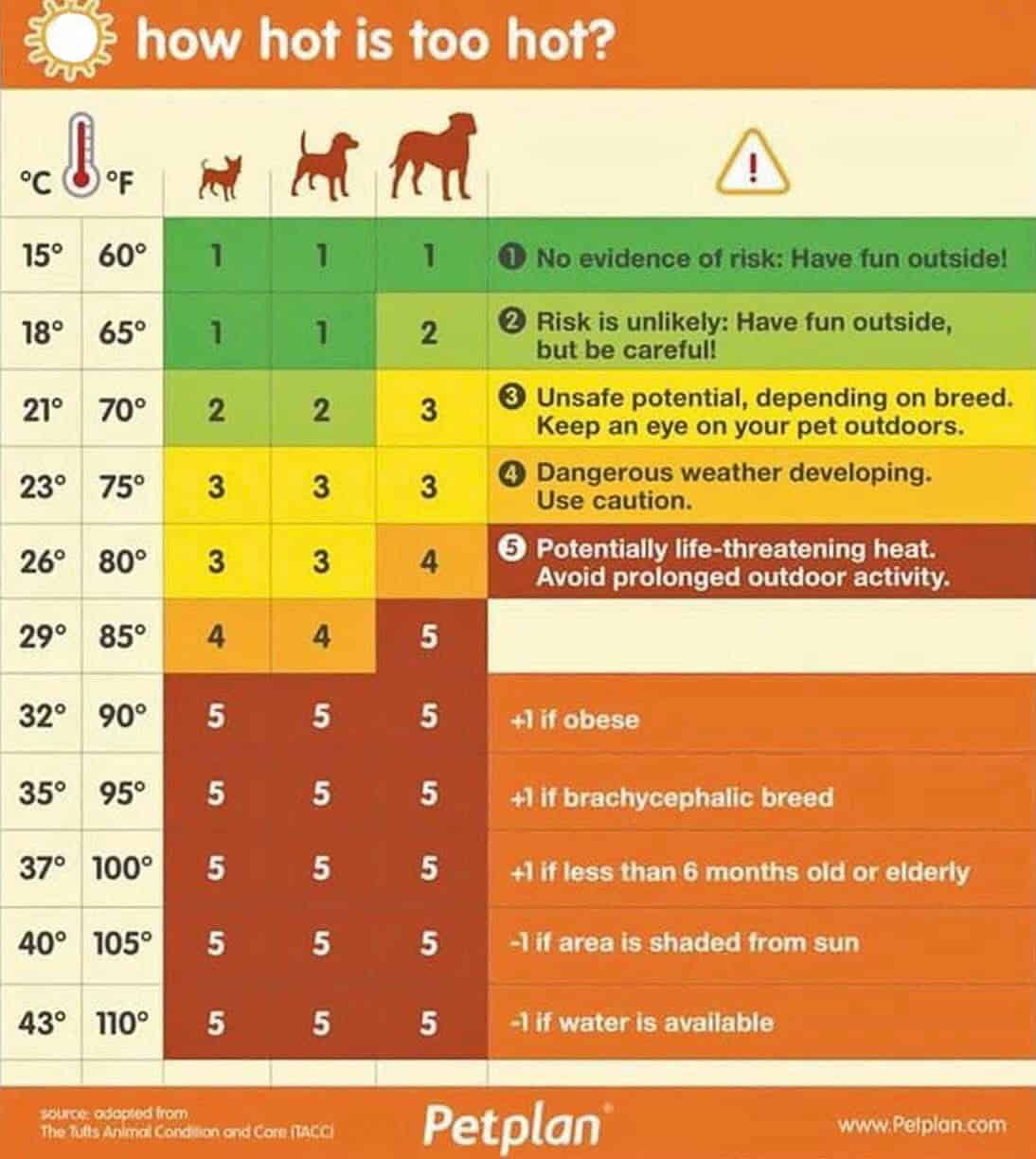
REMEMBER: NEVER leave your pug unattended in a car on a hot day – even if it’s just for a couple of minutes, even if you have left the windows open.

Pugs can die in hot cars in minutes!!!
******
HEATSTROKE.
This is an extremely dangerous condition that can develop if your pug gets too hot with limited ability to sweat and little or no nose/muzzle, they will struggle to lose heat through panting alone, more-so if they are overweight or have other health problems. Very old and very young dogs are most at risk.
Normal body temperature for a dog tends to be between 38-39°C (100.4-102.2°F), this can rise a bit if they are unwell with a fever.
Heat exhaustion typically occurs when a dog’s body temperature rises above 39.4°C, then they are at risk of heatstroke which can cause seizures, organ damage, internal bleeding, coma and be critical for them.
Nearly three quarters of heatstroke cases develop while playing and exercising though it can also be caused by simply sitting somewhere too warm, or being trapped somewhere hot, such as a car, conservatory or room without proper ventilation.
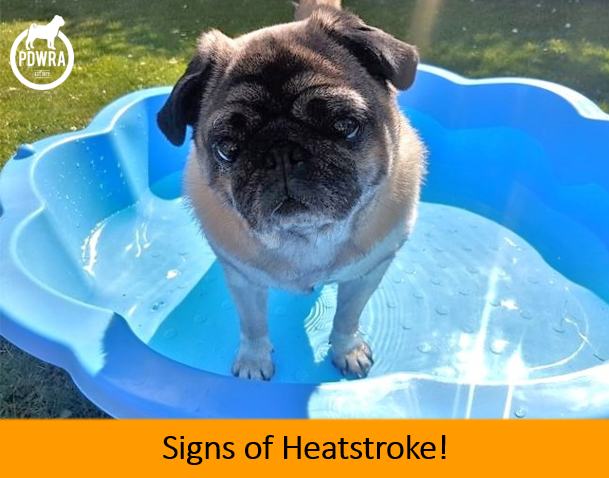
Signs of HEATSTROKE to look for, include:
-
-
- Excessive panting
- Difficulty breathing (fast, heavy, noisy)
- Increased heart rate
- Drooling / Foaming at the mouth
- Diarrhoea (may be bloody)
- Vomiting
- Weakness / Collapse
- Stupor / confusion
- Drowsy & uncoordinated
- Lethargy (low energy)
- Shaking
- Seizures
- Unconsciousness
If your pug experiences any of these symptoms, please seek the advice of your Vet immediately.
Heatstroke is more dangerous the longer it lasts, so the quicker your pug is cooled down and treated by a vet, the better their chance of a full recovery.
In an EMERGENCY:
1) Immediately move your pug to a cooler area, a cool, darkened room or into the shade
2) Cool them down straight away
- Calmly and quickly use cold water (water from the cold tap is fine) over their whole body, or use wet cloths or towels
- Be extremely careful they don’t inhale any water by keeping it away from their nose and mouth
- Offer them a drink of cold water but don’t force them to drink if they don’t want to. Wet their tongue with water instead.
- Create a breeze by opening doors and windows or turning a fan/air-conditioning on
- Put them on top of a cold wet towel.
- Don’t cover them with a wet towel or cuddle them as this will make them even hotter
3) Go to your Vet as soon as possible
- Transport them in an air-conditioned car or with the windows open (ensuring they can’t get out)
- If possible take someone with you to keep cooling them down while you travel
For more advice about heatstroke from PDSA including first-aid, please see:
https://www.pdsa.org.uk/pet-help-and-advice/pet-health-hub/conditions/heatstroke-in-dogs
******
For latest seasonal advice about hazards & tips, please see our webpage:
Seasonal Hazards for Pugs | The Pug Dog Welfare & Rescue Association

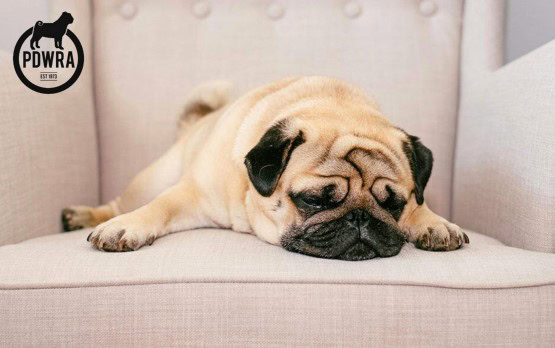
by Yasmin | 10 Jun, 2025 | Blog, Pug Health
Article by Helen McKee (MRCVS) PDWRA Vet Advisor.
How can I tell if my pet still has a good quality of life?
All pet owners want their companion to have a good life. As your pet gets older, or if they’re diagnosed with a serious illness, you may worry that they’re suffering and have more bad days than good.
It can be easy to tell if your pet has a really good quality of life – they’re still playful, active, comfortable and enjoying their food normally. Sometimes, it’ll be very noticeable that your pet is in pain and is suffering after an accident or a sudden illness. But it’s more difficult to notice problems when your pet’s quality of life gradually changes over time.
As owners, we get used to the ways our pets slow down as they age and the extra medications they might need to take. It can be difficult to tell when things start to deteriorate and, emotionally, we might not want to admit that they’re struggling.
It’s important for us to be aware of when things might be getting too much for our pet. It means we can start to prepare ourselves and ensure that our beloved friend won’t suffer.

Measuring your pet’s quality of life
Quality of life isn’t measured by just one thing; it takes into account all of the parts of your pet’s mental and physical wellbeing. This means it can be difficult to measure.
Your vet can help you measure your pet’s quality of life. But your vet only sees your pet during an appointment, and they know you are best-placed to understand how they are getting on day to day.
If their quality of life is getting worse, this doesn’t always mean that it’s time to say goodbye. It’s always best to visit the vet if you notice a change in your pet, even if they already have a diagnosis of a serious illness. There may be other medications or management techniques to help your pet. If other options are not right for your pet, then your vet can give you guidance on when it might be the time to say goodbye. It is particularly important if your pug has a terminal disease and medication cannot keep them comfortable.
You can use the pointers below to regularly check on your pet’s quality of life. It’s good to do this regularly as it can help you spot when things are starting to change.
- Are they in pain?
- Do they shake, tremble or pant, even when they’re resting?
- Do they hide away and not want to be touched or stroked?
- Does it seem to you that their pain medication has stopped working?
- Are they struggling to get around?
- Do they struggle to get up without your help?
- Are they unable to exercise, even just gently?
- Do they lie in the same place all day?
- Do they often fall over or lose their balance?
- Do they pant more than usual or seem to be struggling for breath?
- Are they eating and drinking normally?
- Have they lost interest in food, even turning down their favourite treats?
- Are they being sick or suffering from diarrhoea?
- Are they losing weight?
- Are they going to the toilet normally?
- Is your dog struggling to let you know when they need to go outside?
- Is your pet pooing and weeing where they rest?
- Can they keep themselves clean?
- Do they smell of wee or can’t keep their bum clean?
- Does their fur look duller and less healthy than it used to?
- Has the way they behave changed?
- Have they stopped greeting you when you come home?
- Are they hiding or sleeping in strange places?
- Have they stopped being interested in what’s going on around them?
- Does your pet seem unhappy or unwell in themselves?
- Do they seem confused in normal situations?
- How are you coping with looking after them?
- Do you feel overwhelmed by caring for them?
- Are you worried that you can no longer meet their needs?
- Is it becoming more stressful to give medications to them?
- Are they coping overall?
- Are they having more bad days than good days?
- Is your pet finding being medicated very stressful?
- Put yourself in your pet’s position – how do you think they would rate their quality of life?
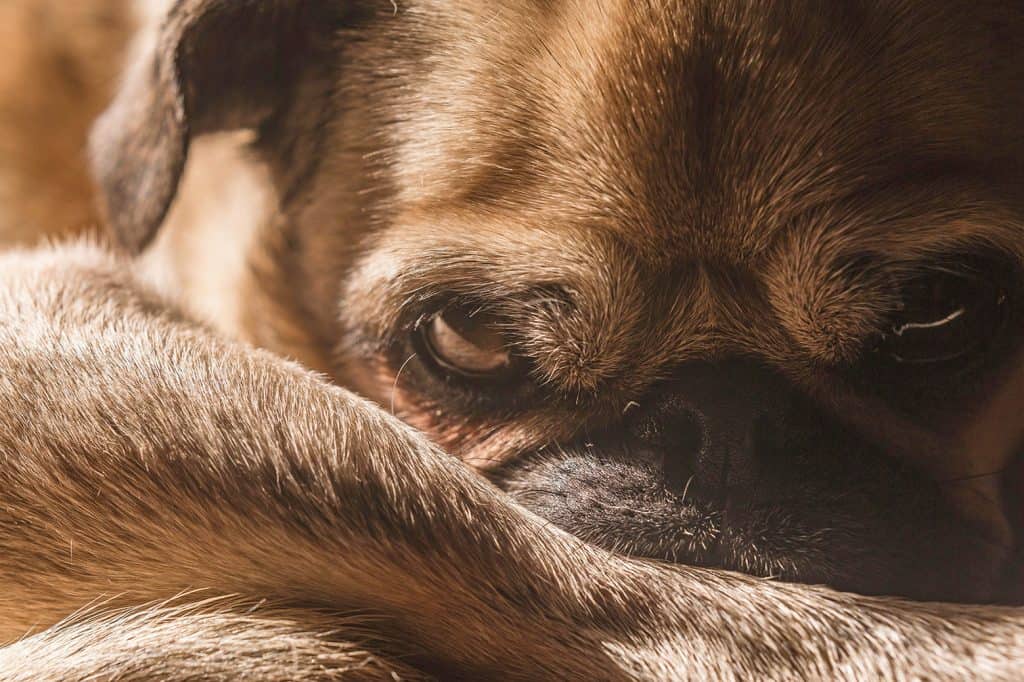
If the answers to many of these questions is yes, it’s a sign your pet is struggling. You can use these questions as a guide to see if their quality of life is changing. You may feel like you’re able to help them through the changes for a while longer or perhaps that it’s time to consider having your pet put to sleep.
You also need to consider what is important from your individual pet’s point of view. If, at their best, they love to chase their ball, then it will have greater impact on their wellbeing if they can’t do this anymore. Other pets may be fairly happy as long as they’re comfortable and not in pain, even though they can’t race around as well as before. As well as considering the questions above, make a list of your pet’s favourite activities. Think about whether your pet is able to do those activities as normal, less than normal but still acceptably, or not at all. It can help to keep a diary or a log to track changes over weeks, or even months.
What should I do next?
Now is the time to speak to your vet. Talk to them about your pet’s quality of life and what your concerns are. The vet will be able to guide and help you make the right decision.
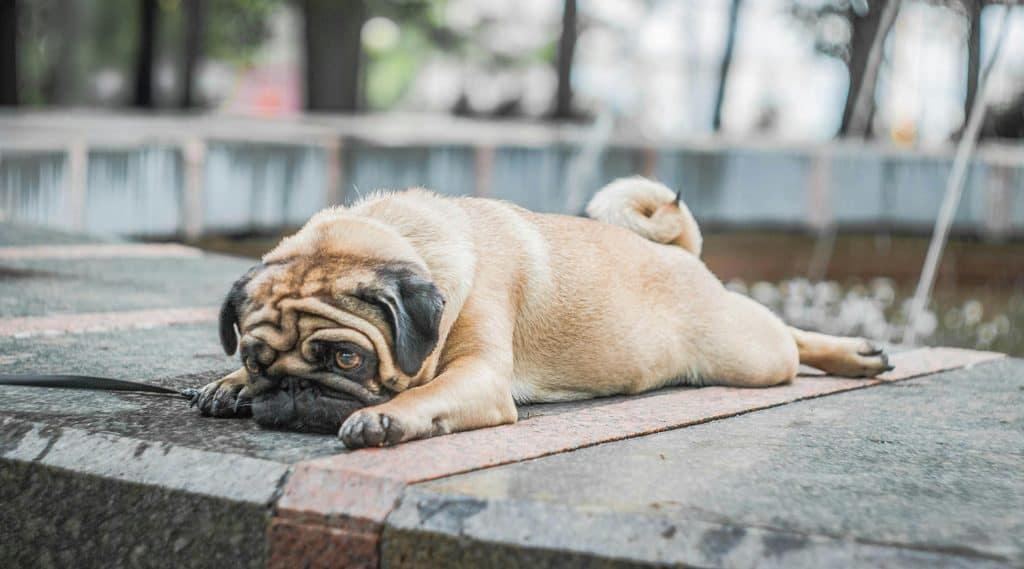
In Summary
Unfortunately, it is rare for a dog to die peacefully at home without some intervention.
We have to decide if there are more bad days than good, and also ask ourselves, are we doing the best by the pug, or are we being selfish.
For me, I feel it is a gift that we can give our beloved companions, so there is no suffering (unlike humans!) and I personally would rather say goodbye a little earlier than leave later when they could be suffering.
Wishing everyone the strength to make the difficult decision we all need to make at some stage as an owner of a pet.
Helen McKee (MRCVS)
PDWRA Vet Advisor.
*****
For other informative pug health articles, please see our web section: https://pugwelfare-rescue.org.uk/pug-health/

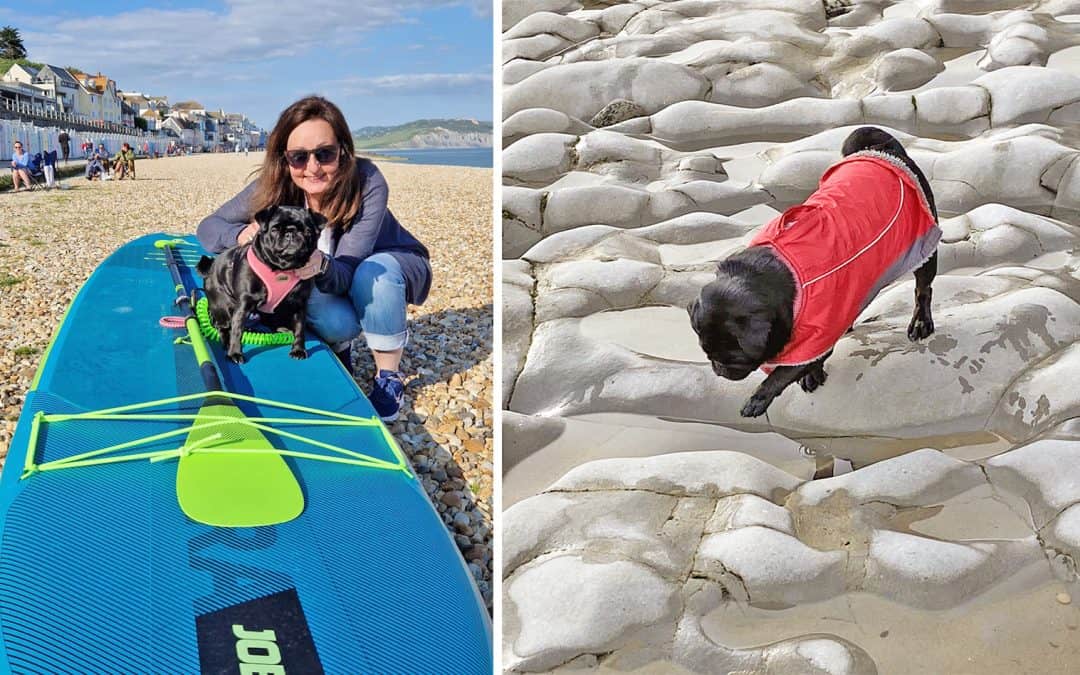
by Yasmin | 10 Jun, 2025 | Blog, Rescue Stories
Way back, I have wanted to have a dog, particularly a pug but I felt blessed to have neighbours who have a grumble and allowed us to care for them when they went away. These were great times. My partner was also very keen to have a dog, but a big one, particularly a German shepherd. After hours of discussion, we agreed that fostering was a good option for us, and a pug would be more suitable to manage. We completed the online forms to be a foster parent, and had a home check and I think at the time I was not expecting to hear anything again. But less than a fortnight later, I received a call from PDWRA asking if we could foster a little girl for 2 weeks who was about to be surrendered. Of course, we said yes, and arrangements were made between the multiple volunteers to make this happen – they really are heroes – the volunteers put their own lives on hold at a moment’s notice, for free to save pugs.
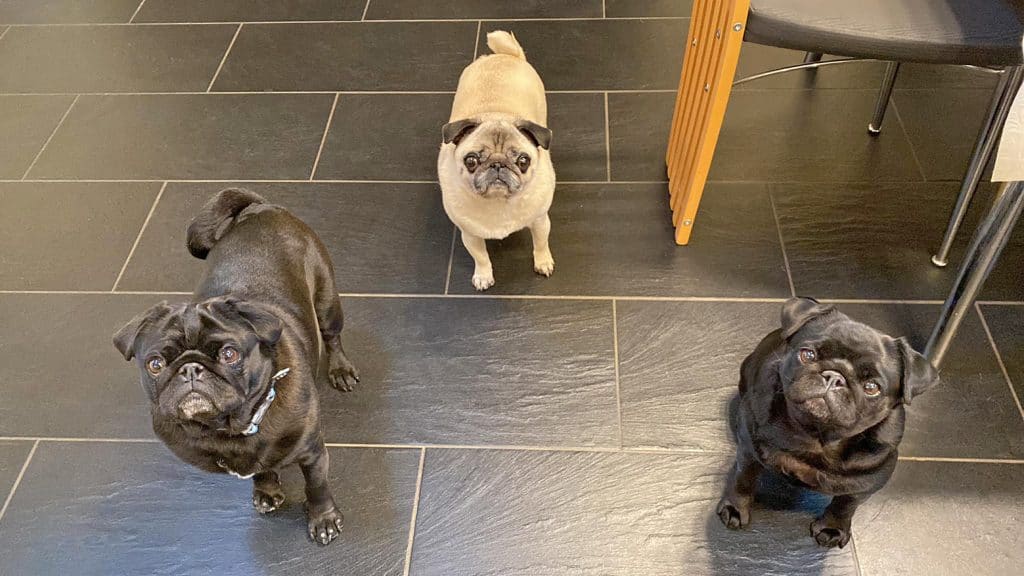
As our foster girl was coming a long way, we met halfway in a service station. The volunteers passed on the information available, and I sat in the back of the car cuddling and soothing a frightened little black pug who cried all the way home.
Once we were back home, we let her explore and she stopped crying and ate her tea. She had a little walk and was a bit more settled. When darkness fell, the howling started, so we spent the night soothing her. Luckily, nothing wrong with her appetite! After a few days, she was slowly becoming more confident, as we were too. After a week, she seemed more settled and happier and the howling stopped. She was enjoying walking with other pugs, exploring the woods, seeking new sniffs and the outdoor sunshine. I recall a particular day, she had just eaten, worn out from a walk, and she jumped on my lap whilst I was on the sofa and just sat still using me for warmth. This was the moment I realised that she could not go to another home. Arrangements were quickly made, and we formally adopted Martha. I love that we failed at fostering!
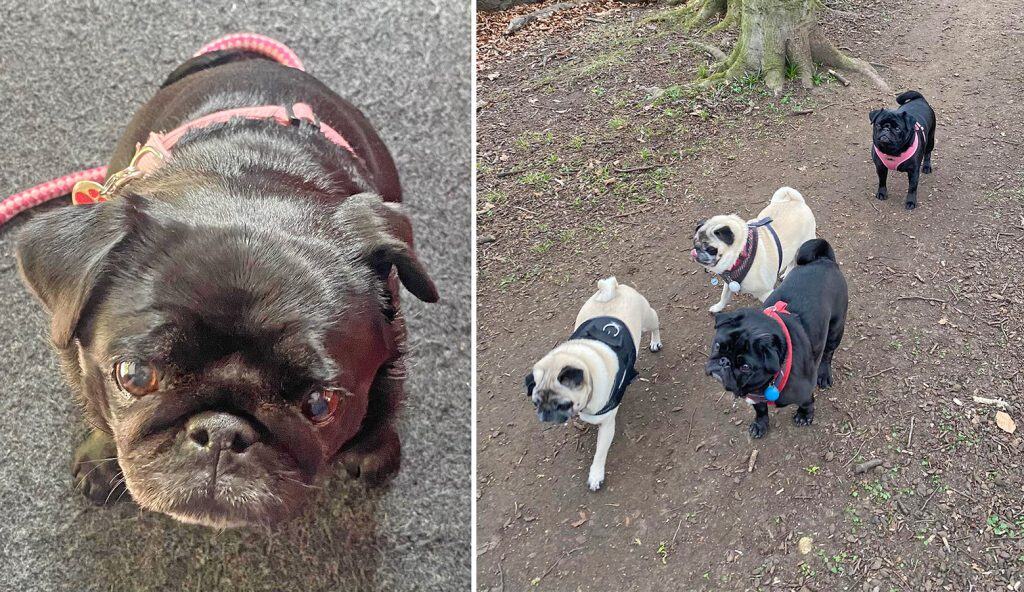
Since then, Martha has become the boss – Breakfast is 8am and dinner is 5pm and there is no deviation permitted! Carrot lunch is 12.30 and must not be forgotten. We never knew how strict a pug routine was! She has suffered from the usual pug things, BOAS surgery, eye ulcer and usual pug tummy issues, but thankfully quick to bounce back. We have adjusted to life with a full-time pug jointly enriching our lives. She comes camping with us, loves the beach and exploring. Martha loves company and lucky to be spoiled rotten by grandparents, she walks daily with the grumble in our neighbourhood and is always first to lead us into coffee shops and restaurants, where she behaves impeccably. She will do anything for treats which we do need to watch!
The PDWRA are amazing, they help change lives for many, and we remain ever grateful. I have transported other pugs and love reading about pug adventures from other fosterers and adopters. Each pug is a lovable force that deserves to live their best life.
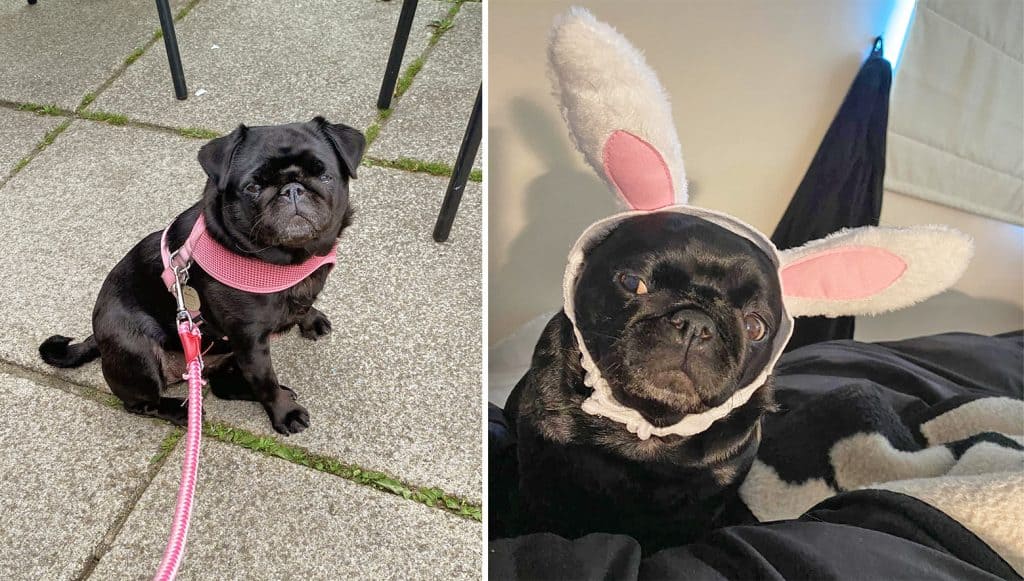
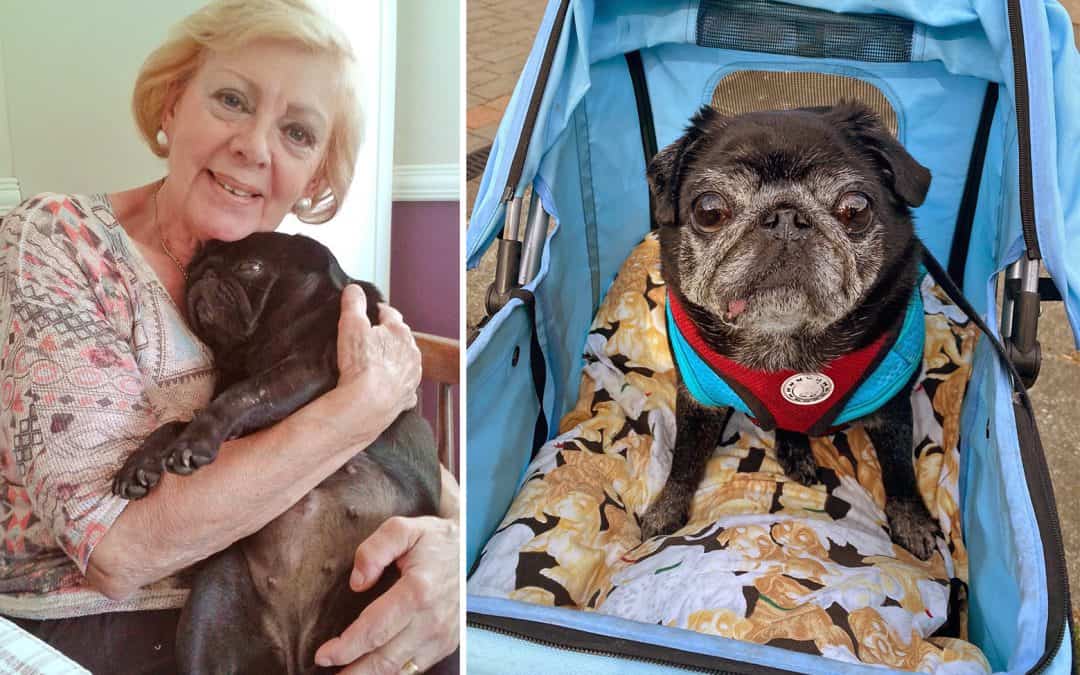
by Yasmin | 10 Jun, 2025 | Blog, Rescue Stories
In April’s newsletter you may have read the article about Laura & her pug Ethel and how her pug story began 40 years ago. Well following on from that, as Laura is my daughter, here is my story of how I discovered Pug Welfare and my pug journey.
Having bought from a breeder, our first pug Honey in 1984, during a chance meeting while out on a dog walk with Honey a fellow pug owner told me about PDWRA and the annual Pug Days at Crowhurst. We sadly lost Honey in 1994 and after her loss we decided to go down the rescue route as PDWRA seemed such a great organisation to adopt through. Over the past 30 + years I have had the pleasure of adopting :- Hanky Panky, Millie, Lily, Mabel and finally, our precious Black Betty, who has been with us for the past 10 years.
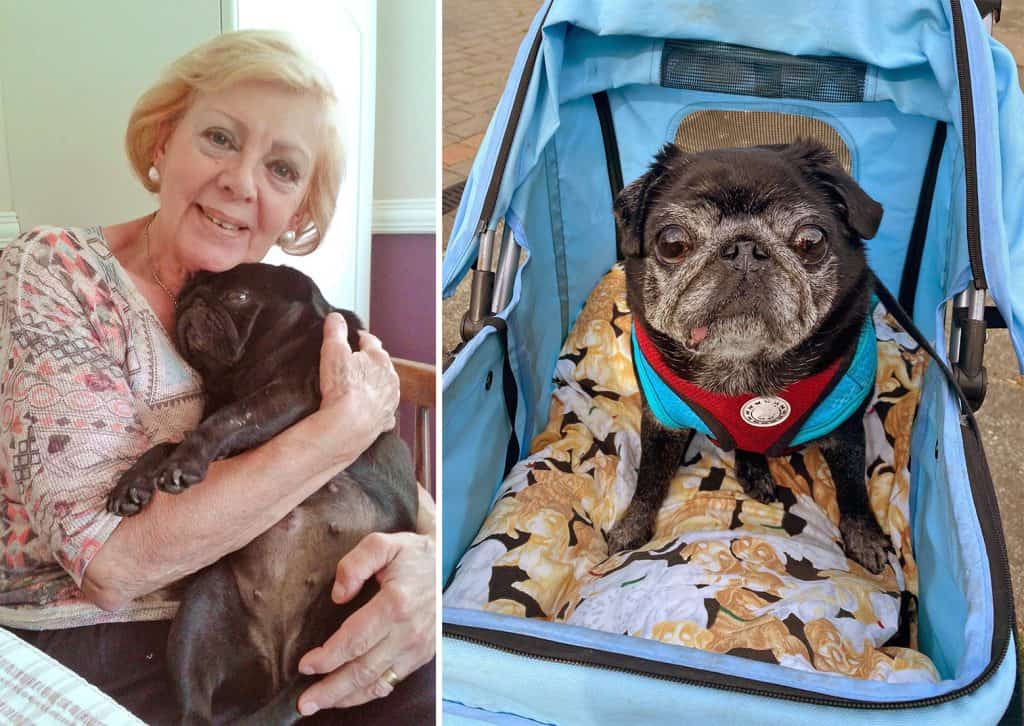
I found the process of adopting through PDWRA quite straight forward and it became easier for us as time went by, after each adoption we didn’t have to wait too long to receive a call from Pug Welfare with our next adoptee. Over the years, all our girls were taken to almost every Welfare Day at Crowhurst from 1987 until 2016, when sadly they became no more. They were a great day out, games for the pugs, raffles and various different stalls, plus the much loved auction to raise money for pug welfare. Another not to be missed PDWRA occasion were the Pug Tea Parties that were held once or twice a year during the summer months, the pugs and the humans who always had a great time!!
The pugs I have adopted have always enjoyed a holiday away with us, over the years they have been to Yorkshire, Norfolk, down to Devon and to the Witterings in West Sussex, and nearer to us on the Kent coast. I must say, although the girls have always enjoyed a change of scenery, running on the sand – definitely not in the water! or enjoying a new walk and smells in the Countryside, they always loved getting home, back into their comfort zone! This goes especially for Betty, she’s a real home pug and loves her daily routine.
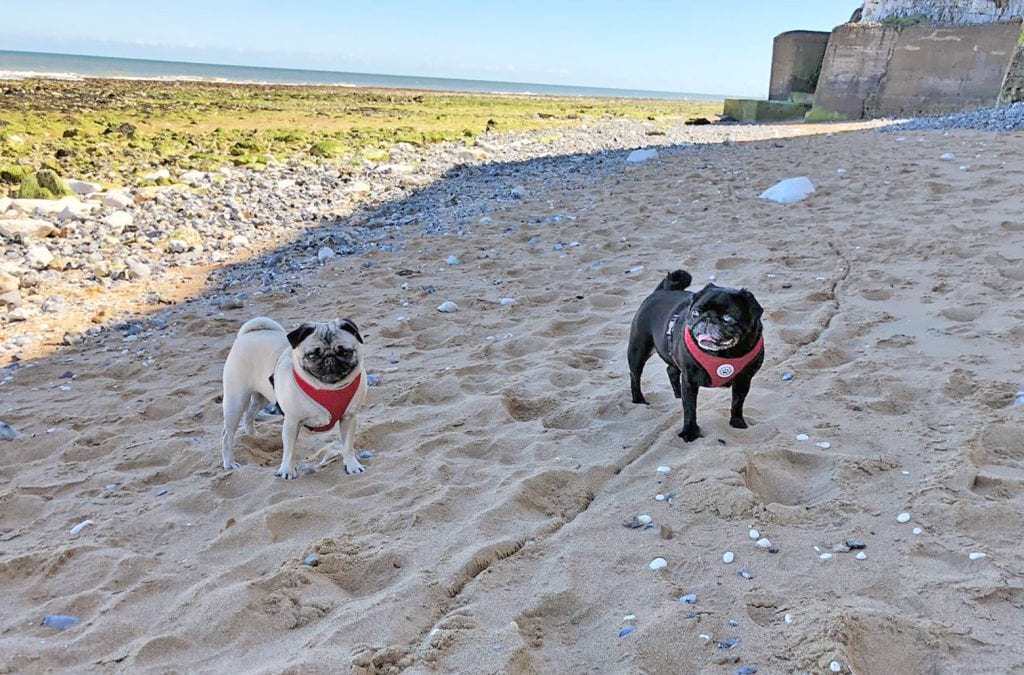
We adopted Betty in 2015, she was a little over 5 years old and my most vivid memory of her is arriving at 2pm on the 26thMarch. Judi and Andrew pulled onto the drive and out jumped the prettiest, bright eyed little black pug, who promptly breezed into our lives as much to say “well I’m here”! She had a quick look around, made sure she had no opposition and everything met with her standards and approval, checked out the garden, christened the grass and decided she’d stay!!!
Betty has been a joy to have in our lives, as an elderly lady now she has become even more feisty and stubborn, aging ladies do have that privilege. Her sight is not so good now and Betty has arthritis in her back, but she copes well with her eye drops and her regular injections at the vets and she still retains the loveable character she has always been blessed with. Due to Betty’s advanced years, she has just celebrated her 15th Birthday, her favourite pastimes now are eating, sniffing lampposts, barking at anything and sleeping, in any particular order!!
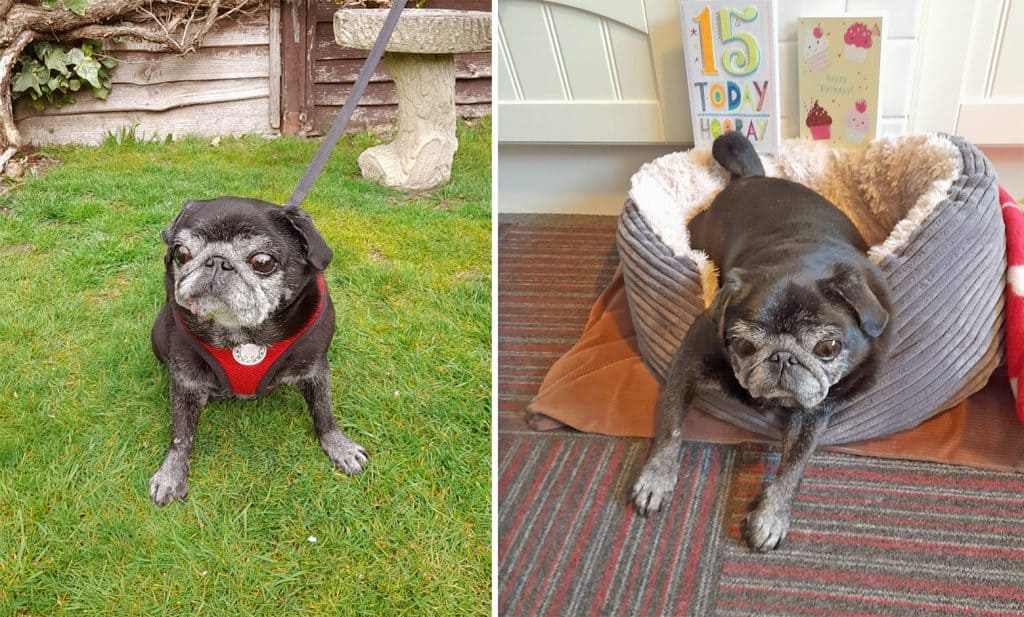
Obviously over the past 40 years there have been ups and downs with looking after a pug, the sheer overwhelming sadness when one of the girls have passed away, but such happiness when a new little pug arrives, full of enthusiasm to start a new life in their forever home.
If I was ever asked “would I pursue the adoption route again after over 30 years?”, I would answer a resounding yes in a heartbeat. Young, middle years or an oldie, each pug brings their own character and rewards you with love and the trust they give you, is such a beautiful thing.
I feel so grateful to have shared such a large part of Betty’s life, and parts of all the other girls who have gone before, and also my 35 years of being part of such a wonderful pug charity. Plus, the added assurance that you are always able to contact PDWRA if you need any medical advice or support, the members are always there to help and advise.
Hopefully PDWRA will continue their brilliant work rehoming our lovely breed for another 50+ years.
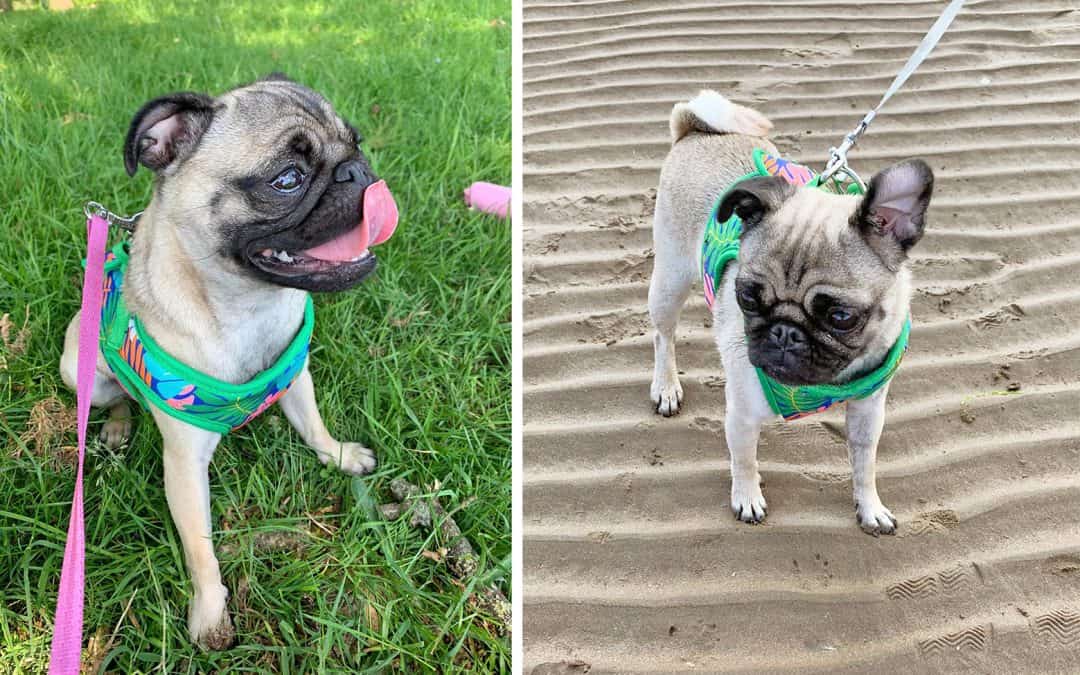
by Yasmin | 10 Jun, 2025 | Blog, Rescue Stories
Why pugs, why rescue, why the PDWRA? This for us began a long time ago, my eldest son (now 16) fell in love with pugs when he was 4 after meeting a very handsome pug on the Isle of Wight called Dave. A love affair began, which never dwindled, however we could never own a pug because my husband was allergic to pet hair. Fast forward many years and a divorce later, also back on the Isle of Wight, a pug was on holiday in the caravan next to us !! It is fair to say that my son did not relent in his persistence over owing a pug & fate has a funny way sometimes. When we returned home, the research began. I knew I wanted to rescue a dog, there was no way I was buying a puppy when so many dogs need a forever home and the most important part was that whoever came our way, their name had to be Dave.
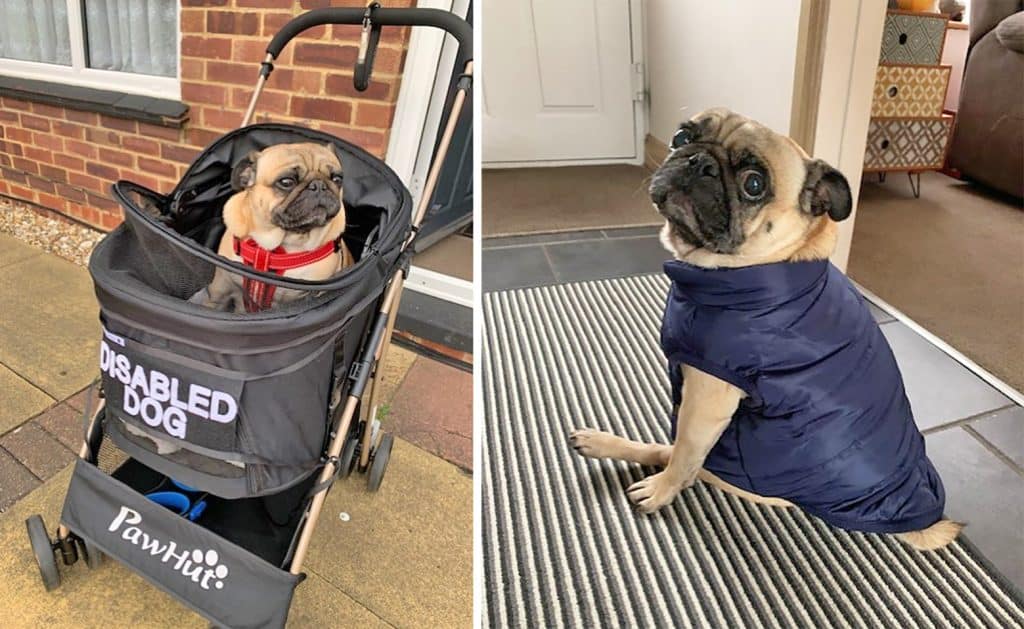
I researched local pug rescue teams, found the PDWRA and applied. Thankfully we passed all the interviews and were placed on the adoption register. A call came through sometime later asking if we would consider a lovely boy with wonky legs and with a resounding ‘yes’ from our little family of 3 Dave became ours.
I knew nothing about pugs, a lot about dogs but not pugs. I have totally fallen in love with their wacky little characters, their need to be with you, the fact that they are as excited to see you if you have gone into the garden and come straight back in or if you have popped off to the shops, the fact that they have to be on your lap if you are sitting down.
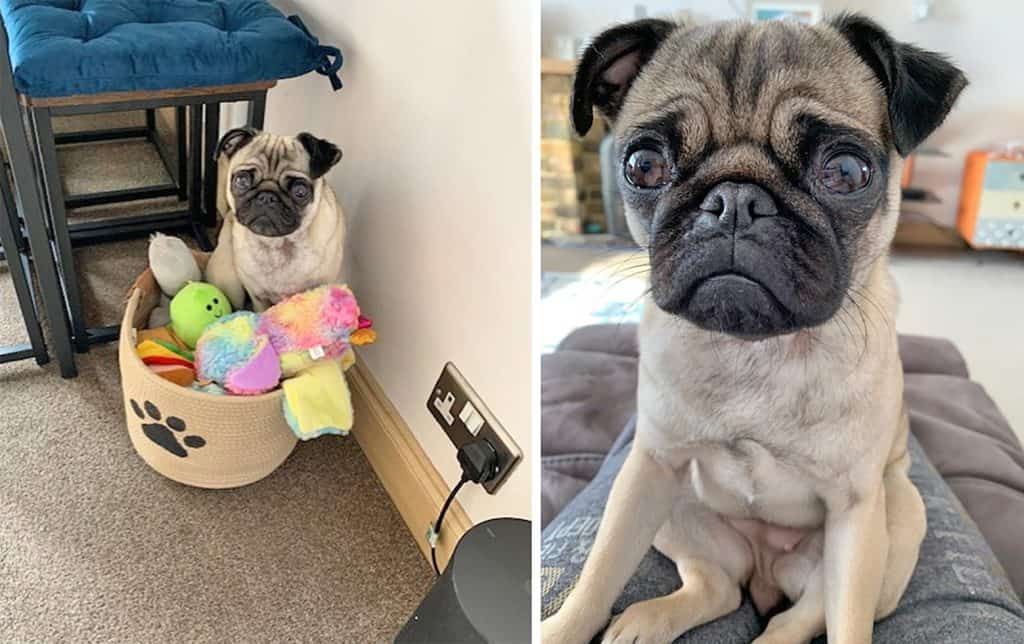
We were smitten! We utterly adored Dave and his existence in our lives changed a lot of things for the better. Sadly, he became very ill, very quickly, a year after we adopted him and was put to sleep in December of 2023. I have known heartbreak but nothing on this level, so whilst scrolling the PDWRA Facebook page in the following January, getting my fix of puggy beauties, I saw a post asking if anyone could give a cute, tiny little innocent looking lady a home! Cue Sandra ….. a sign from Dave I think! She is a pint-sized hurricane of a dog…
We adopted our chaotic 4kg bundle of energy, also known as Sandra, in February 2024 and have not looked back. She is hilarious, stubborn and totally adorable, she absolutely has us wrapped around her little paws. She is our world and owns us, it is not the other way around and our lives are infinitely better with her in charge of our house.
